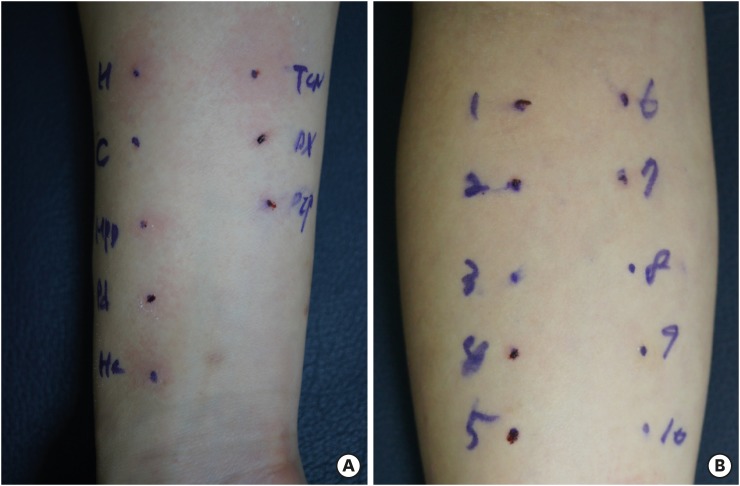J Korean Med Sci.
2018 Mar;33(12):e87. 10.3346/jkms.2018.33.e87.
Immediate Hypersensitivity Reactions Induced by Triamcinolone in a Patient with Atopic Dermatitis
- Affiliations
-
- 1Department of Dermatology, Hallym University Kangnam Sacred Heart Hospital, College of Medicine, Hallym University, Seoul, Korea. dermap@hanmail.net
- KMID: 2406882
- DOI: http://doi.org/10.3346/jkms.2018.33.e87
Abstract
- Corticosteroids are potent anti-inflammatory and anti-allergic agents used in the treatment of various inflammatory diseases, including allergic disease. They are frequently considered the therapy-of-choice for many skin diseases. However, allergic reactions caused by corticosteroids have been reported. Among these, delayed reactions to topical steroids are more common, whereas immediate reactions to systemic steroids are rare. Herein, we report the case of a 32-year-old woman with triamcinolone-induced immediate hypersensitivity reaction, in which the patient had a positive prick test result with triamcinolone. She has had atopic dermatitis (AD) for three years. She had used systemic steroid, cyclosporine, and antihistamine with topical steroids for AD. In clinic, approximately 10 minutes after intralesional injection of triamcinolone, she complained of erythematous patches with slight elevation and itching on the face, trunk, and both hands. After intravenous injection of dexamethasone, her symptoms got worse. After treatment with epinephrine, all symptoms resolved within two hours. We performed an open test and skin prick test. She had a positive result only from the prick test with triamcinolone; all other steroids showed negative results from the open tests. Dermatologists should be aware of the possibility of anaphylaxis or other allergic hypersensitivity in response to corticosteroids.
Keyword
MeSH Terms
-
Adrenal Cortex Hormones
Adult
Anaphylaxis
Anti-Allergic Agents
Cyclosporine
Dermatitis, Atopic*
Dexamethasone
Epinephrine
Female
Hand
Humans
Hypersensitivity
Hypersensitivity, Immediate*
Injections, Intralesional
Injections, Intravenous
Pruritus
Skin
Skin Diseases
Steroids
Triamcinolone*
Adrenal Cortex Hormones
Anti-Allergic Agents
Cyclosporine
Dexamethasone
Epinephrine
Steroids
Triamcinolone
Figure
Reference
-
1. Baeck M, Marot L, Nicolas JF, Pilette C, Tennstedt D, Goossens A. Allergic hypersensitivity to topical and systemic corticosteroids: a review. Allergy. 2009; 64(7):978–994. PMID: 19416135.
Article2. Rietschel RL. Contact dermatitis and diagnostic techniques. Allergy Proc. 1989; 10(6):403–411. PMID: 2534095.
Article3. Knarborg M, Bendstrup E, Hilberg O. Increasing awareness of corticosteroid hypersensitivity reactions is important. Respirol Case Rep. 2013; 1(2):43–45. PMID: 25473540.
Article4. Patel A, Bahna SL. Immediate hypersensitivity reactions to corticosteroids. Ann Allergy Asthma Immunol. 2015; 115(3):178–182.e3. PMID: 26211812.
Article5. Ahn YH, Koh YI, Kim JH, Ban GY, Lee YK, Hong GN, et al. The potential utility of iodinated contrast media (ICM) skin testing in patients with ICM hypersensitivity. J Korean Med Sci. 2015; 30(3):245–251. PMID: 25729245.
Article7. Kekki OM, Turjanmaa K, Isolauri E. Differences in skin-prick and patch-test reactivity are related to the heterogeneity of atopic eczema in infants. Allergy. 1997; 52(7):755–759. PMID: 9265992.
Article8. Lahti A. Nonimmunologic contact urticaria. Amins S, Lahti A, Maibach HI, editors. Contact Urticaria Syndrome. Boca Raton, FL: CRC Press;1997. Chapter 3.10. Helaskoski E, Kuuliala O, Aalto-Korte K. Occupational contact urticaria caused by cyclic acid anhydrides. Contact Dermat. 2009; 60(4):214–221.
Article11. Vatti RR, Ali F, Teuber S, Chang C, Gershwin ME. Hypersensitivity reactions to corticosteroids. Clin Rev Allergy Immunol. 2014; 47(1):26–37. PMID: 23567983.
Article12. Dajani BM, Sliman NA, Shubair KS, Hamzeh YS. Bronchospasm caused by intravenous hydrocortisone sodium succinate (Solu-Cortef) in aspirin-sensitive asthmatics. J Allergy Clin Immunol. 1981; 68(3):201–204. PMID: 7264102.
Article13. Partridge MR, Gibson GJ. Adverse bronchial reactions to intravenous hydrocortisone in two aspirin-sensitive asthmatic patients. BMJ. 1978; 1(6126):1521–1522. PMID: 656781.
Article14. Wilkinson SM, Morrey K, Hollowood K, Heagerty AH, English JS. HLA-A, -B and -DR antigens in hydrocortisone contact hypersensitivity. Contact Dermat. 1993; 28(5):295–297.
Article15. Bundgaard H. The possible implication of steroid-glyoxal degradation products in allergic reactions to corticosteroids. Arch Pharm Chem Sci Ed. 1980; 8:83–90.16. Kim JE, Kim HJ, Lew BL, Lee KH, Hong SP, Jang YH, et al. Consensus guidelines for the treatment of atopic dermatitis in Korea (part II): systemic treatment. Ann Dermatol. 2015; 27(5):578–592. PMID: 26512172.
Article17. Whitmore SE. Delayed systemic allergic reactions to corticosteroids. Contact Dermat. 1995; 32(4):193–198.
Article
- Full Text Links
- Actions
-
Cited
- CITED
-
- Close
- Share
- Similar articles
-
- Patch test and Specific IgE Concentration with House Dust Mite Antigens in Atopic Dermatitis Patients
- Two Cases of Atopic Dermatitis Developing Ocular Complication and Immunological Disturbance
- Erratum: Retraction of Figure 1 in the Article “Immediate Hypersensitivity Reactions Induced by Triamcinolone in a Patient With Atopic Dermatitis”
- A Case of Atopic Dermatitis due to Peanut Allergy
- Atopic dermatitis


